The HTC One X for AT&T Review
by Brian Klug on May 1, 2012 6:00 PM EST- Posted in
- Smartphones
- Snapdragon
- HTC
- Qualcomm
- MSM8960
- Krait
- Mobile
- Tegra 3
- HTC One
- NVIDIA
This is our the first smartphone we’ve seen with a 28nm SoC, and thus battery life is the big question. Further, the handset includes all the onboard MSM8960 radio goodness as we’ll mention in a bit. The problem with some HTC phones for the longest time was that they shipped with smaller than average batteries - while the competition continued up past 6 Whr, HTC would ship phones with 5 or so. That changes with the HTC One X, which includes a 6.66 Whr (1800 mAh, 3.7V) internal battery. I’m presenting the same battery capacity chart that we did in the Xolo X900 review for a frame of reference.
Like we did with the X900 review, we’re going to present the normalized battery performance - battery life divided by battery capacity - to give a better idea for how this compares with the competition.

As a reminder, the browsing tests happen at 200 nits and consist of a few dozen pages loaded endlessly over WCDMA or WiFi (depending on the test) until the phone powers off. The WiFi hotspot tethering test consists of a single attached client streaming 128 kbps MP3 audio and loading four tabs of the page loading test through the handset over WCDMA with the display off.
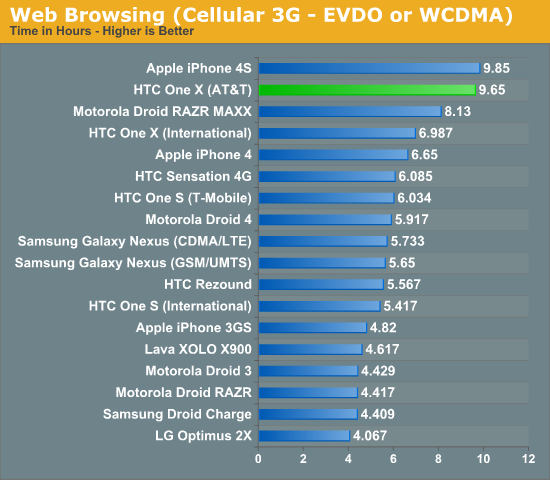
HTC is off to an incredible start with our 3G web browsing tests. Even if you assume that Android and iOS are on even footing from a power efficiency standpoint, the HTC One X is easily able to equal Apple's best in terms of battery life. In reality my guess is that the 4S is at a bit of an unfair advantage in this test due to how aggressive iOS/mobile Safari can be about reducing power consumption, but either way the AT&T One X does amazing here. The advantage isn't just because of the larger battery either, if we look at normalized results we see that the One X is simply a more efficient platform than any other Android smartphone we've tested:
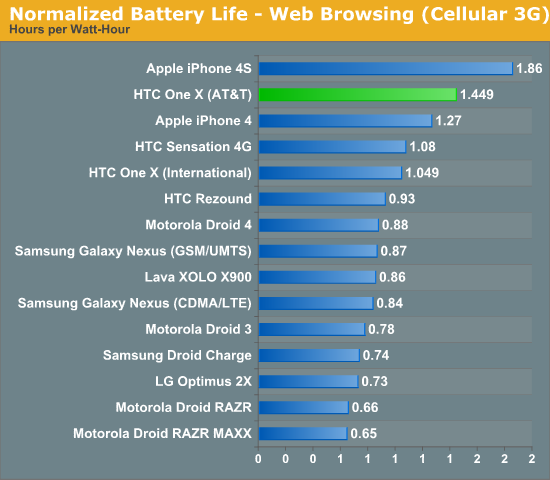
The Tegra 3 based international One X doesn't do as well. NVIDIA tells us that this is because of differences in software. We'll be testing a newer build of the One X's software to see how much of an improvement there is in the coming days.
Moving onto WiFi battery life the AT&T One X continues to do quite well, although the Droid 4 and RAZR MAXX are both able to deliver longer battery life in this case:

There are too many variables at play here (panel efficiency, WiFi stack, browser/software stack) to pinpoint why the One X loses its first place position, but it's still an extremely strong performer. Once again we see a noticeable difference between it and the international One X.
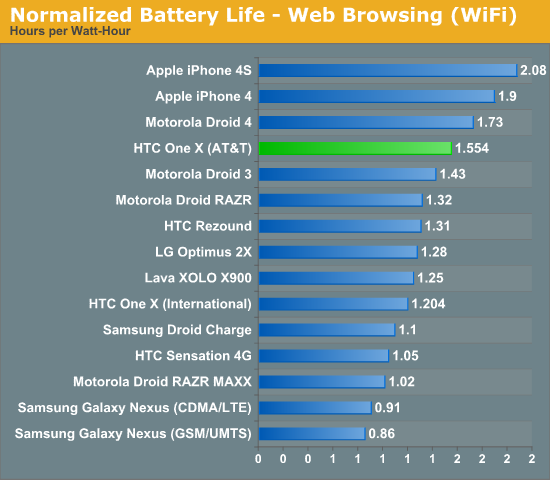
The big question is how well does the AT&T One X do when we're using the MSM8960's LTE baseband? Pretty darn well, when you consider that it's bested only by the RAZR MAXX with its gargantuan battery. Probably the most notable comparison point here is the HTC Vivid or Galaxy Note on AT&T which both are based on the APQ8060 + MDM9200 combination.
As a reminder, the Verizon / CDMA2000 LTE devices here are at a bit of a disadvantage due to virtually all of those handsets camping CDMA2000 1x for voice and SMS. The AT&T LTE enabled devices use circuit switched fallback (CSFB) and essentially only camp one air interface at a time, falling back from LTE to WCDMA to exchange a call.
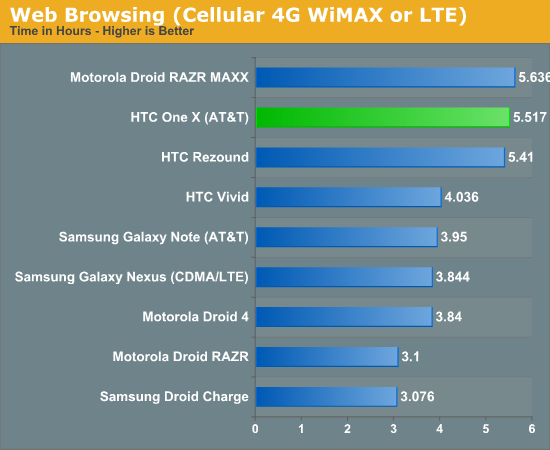
This particular graph doesn't tell the full story however. In practice the AT&T One X seems to last a lot longer using LTE than any LTE Android phone we've tested in the past. Nipping at the heels of the RAZR MAXX, we need to look at normalized battery life to get an idea of just how efficient the new 28nm LTE enabled SoC is:
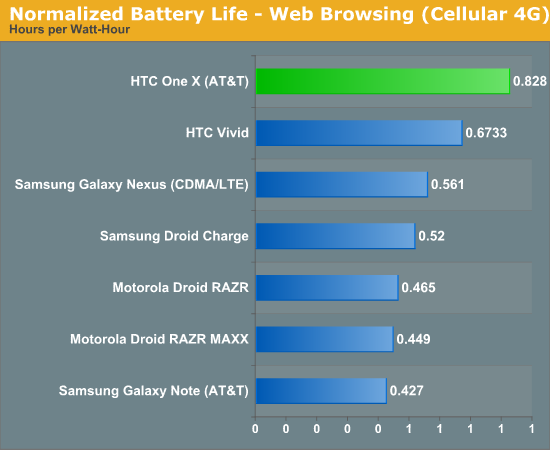
Now that we have 28nm baseband we've immediately realized some power gains. As time progresses, the rest of the RF chain will also get better. Already most of the LTE power amplifiers vendors have newer generation parts with higher PAE (Power-Added Efficiency), and such improvements will hopefully continue to improve things and gradually bring LTE battery life closer to that of 3G WCDMA or EVDO.
Using the AT&T One X as a WiFi hotspot is also going deliver a pretty great experience:
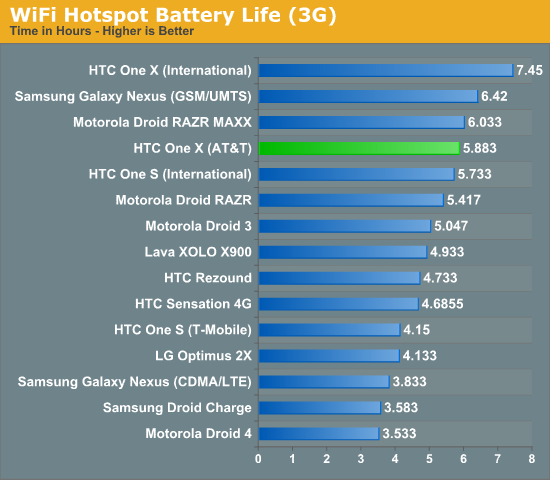
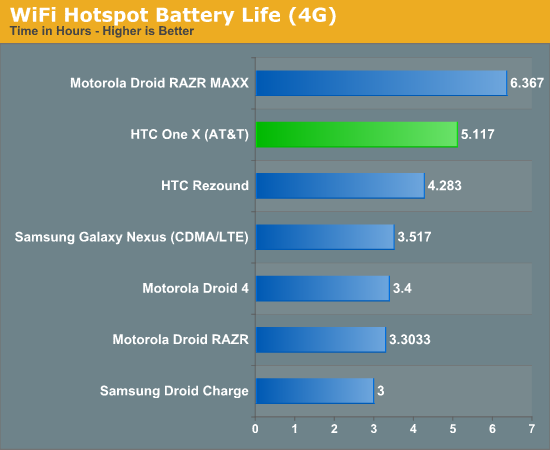
As an LTE hotspot the RAZR MAXX's larger battery is able to deliver a longer run time, however the One X does very well given its battery capacity and size.
Finally, our cellular talk time charts put the AT&T One X in the upper half of our results. Overall the AT&T One X appears to do very well across the board, but it's very strong in the 3G/LTE tests.
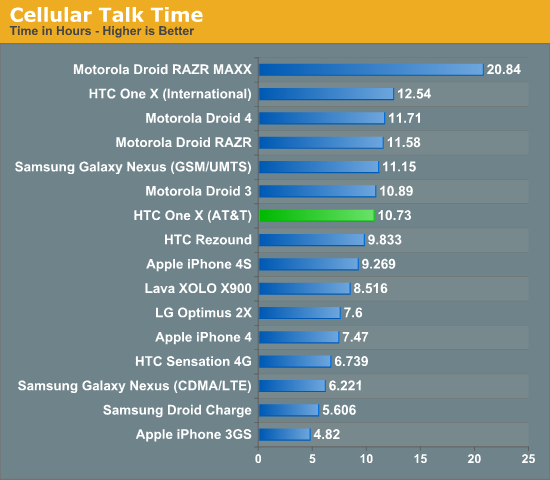
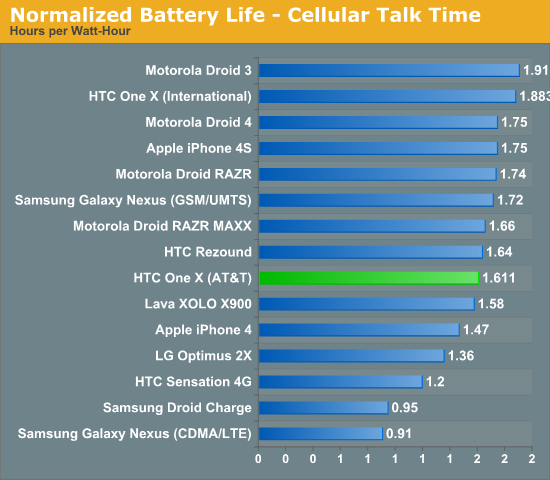










137 Comments
View All Comments
antef - Friday, May 4, 2012 - link
Oh, interesting, thanks for clearing that up!1ceTr0n - Wednesday, May 2, 2012 - link
But i'll stick with my new white and sexy Galaxy Noteakyp - Wednesday, May 2, 2012 - link
"What’s really interesting to me is just how many recent handsets from so many other OEMs have taken a similar design approach - microSIM, unibody polymer construction, no microSD card slot, and non removable battery. That combination of features seems necessary if you’re going to craft a device with competitive form factor this generation, and no doubt even more vendors will update with that profile. Polymer makes sense because it’s both a material transparent to RF, and easy to machine, and going with a microSIM makes sense since it’s all about minimizing area that isn’t dedicated to battery."I strongly disagree with this trend and I think this is right up there with glossy 768p notebook displays in terms of absurdity and simply got to stop. It's not about making the device slim nor maximizing battery, as the One X stands out in neither. It's all about cutting cost and forcing users to upgrade devices sooner because the battery has gone bad and cannot be replaced easily, or the internal storage has run out and there's no way to expand it with a microSD. MicroSIM is an abomination created by Apple just because they can.
xype - Wednesday, May 2, 2012 - link
"The One X on AT&T is really a One XL (L for LTE), however in the USA the device carries full One X branding. We’ve got the International One X and One S variants which will be reviewed in short order, but for today we’re talking specifically about the One X on AT&T."Every time someone will tell me that Android branding is NOT confusing I will point them to this paragraph. Damn, you’d think the people at HTC are all retarded or something.
Sabresiberian - Wednesday, May 2, 2012 - link
I've never owned a smart phone so maybe it's not the problem it is on monitors for desktop and portable computers, but I'm concerned about these screens getting narrower. I'd like to see that trend change, I think. In this, Apple looks to me like it's doing a better job.;)
Impulses - Wednesday, May 2, 2012 - link
This screen is actually ever so slightly wider than last gen 4.3" qHD displays... Tho those were slightly narrower than the first 4.3" displays, so it's kind of a wash really. The iPhone's display is just smaller in every direction, I don't see how that's an improvement unless you have tiny hands or shallow pockets... If that's the case there's always the One S, it's barely any wider than the iphone, about half an inch longer, but it packs in a 4" display (shame it's Pentile qHD tho (.jefffeely - Wednesday, May 2, 2012 - link
"The rear facing CMOS is a Samsung S5K3H2YX which Vivek spotted in the MyTouch 4G Slide. "The Rezound has the same camera module as well.
I would love to see a camera comparison between the One X and another phone with the same module so as to see how much of a difference the dedicated ISP makes. Oh darn, guess I'll just have to go buy an One X now.
As a side note: thank you so much for doing this review. It is nice to be able to find something unbiased in the sea of hype.
quiksilvr - Wednesday, May 2, 2012 - link
In the Camera Section for iPhone 4S, it says:8 MP with LED Flash, Front Facing Camera
But that is not correct. It SHOULD say:
8 MP AF/LED Flash, VGA Front Facing Camera
ssj3gohan - Wednesday, May 2, 2012 - link
The decibel scale being logarithmic, it's pretty much useless to graph it linearly. You get the false impression that for instance something that has a 77dB loudness is 'just' 5% less loud than something at 80dB, while in fact it's a 100% difference.The loudness graphs would be much more informative if they would convey these actual differences. There are big, big differences between speaker loudness of phones and it is a legitimate point of review.
skiboysteve - Wednesday, May 2, 2012 - link
I agree in principle, but 3dB is not twice as loud. 5-10 dB is.I actually thought 3dB was twice as loud for a long time but someone finally showed me I was wrong. Google it :)